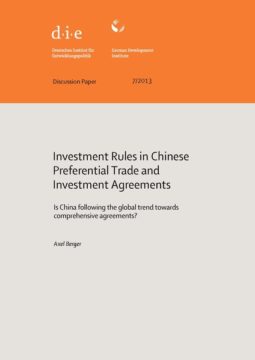Is China joining this trend towards preferential trade and investment agreements (PTIAs) that go beyond the investment rules found in Chinese bilateral investment treaties (BITs)? In this paper I empirically analyse investment rules incorporated in Chinese PTIAs using China’s BIT practice and the international PTIA practice as benchmarks. The empirical analysis is based on a content analysis of Chinese PTIAs and BITs as well as selected partner country PTIAs. In addition to secondary academic sources, I conducted interviews with Chinese officials as well as relevant stakeholders and negotiators of a number of China’s partner countries to shed light on the policy process driving the developments of China’s PTIA practice. Based on this empirical analysis, I argue that China is pursuing a partially “NAFTA-ized” PTIA policy that is coherent with what China is willing to offer in the context of some of its more recent BITs. I show that innovative treaty language diffuses from its partner country PTIA policies in the process of negotiations towards China’s PTIA policy. Accepting the partner countries’ model texts as the basis for negotiations, innovative treaty language – including references to the international minimum standard, prohibition of performance requirements, transparency rules and environmental provisions – spreads to Chinese PTIAs. However, China stops short of consenting to partner countries’ push towards the inclusion of commitments to liberalise its investment regime. For the Chinese government, PTIAs are not seen as a laboratory to go beyond the narrow focus of its BITs. Quite the opposite, its BIT practice defines the limits of China’s PTIA policy.
- Veröffentlicht am Montag 8. April 2013 von Deutsches Institut f. Entwicklungspolitik
- ISBN: 9783889856296
- 34 Seiten
- Genre: Gesellschaft, Politik, Sachbücher, Wirtschaft
